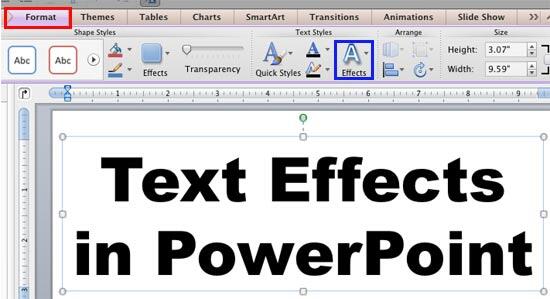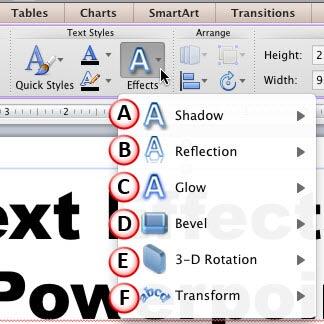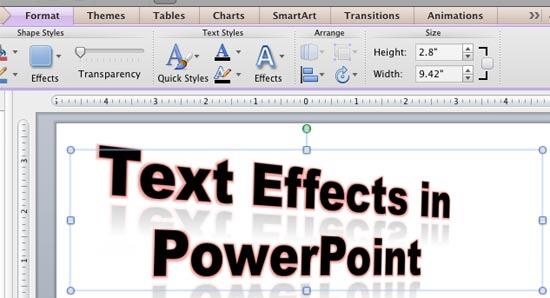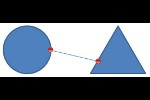Text is best left alone most of the time. Plain text with a solid color can look so clean and understated that it really does not make any sense
playing too much with its appearance. Yet there are times when you want a single word or phrase to stand out. It's for those few times that you
should explore stylizing your text in PowerPoint. Among these stylizing options, we have already explored
Text Fills and
Text Outlines, and we have also learned how to apply various
WordArt styles in PowerPoint. Now let us learn how to apply
and edit various text effects such as Shadow, Reflection, Glow, 3-D Rotation,
Transform, etc, to your text. Follow these steps to learn more in
PowerPoint 2013 for Windows:
- Select the text to which you want to apply a text
effect. Alternatively, if you just want to follow this tutorial step-by-step,
insert a text box on a blank slide and type some text in
it. Also, change the text font to something
"blocky", such as Arial Black (see Figure 1). Select the text, or
select the entire text container by clicking on
the edge of the placeholder, to bring up the Format tab on the
Ribbon as shown highlighted in red within
Figure 1.

Figure 1: Format tab of the Ribbon- Within the Format tab, click the Effects button highlighted in blue within
Figure 1 above.
Note: The
Format tab is a
Contextual tab. Contextual tabs are special tabs in the
Ribbon that are not visible all the time. They make an appearance
only when you are working with a particular slide object which can be edited using the options within these tabs.
- This opens the Effects drop-down gallery, as shown in Figure 2.

Figure 2: Effects drop-down gallery- Let us explore the options within Effects drop-down gallery, as marked in Figure 2. Note that all
options within the Effects drop-down gallery for text (except the Transform option) work in the same way as the options within the
Effects drop-down gallery for Shapes. So, even though
the procedures explained in the linked tutorials below are for shape effects, they work for text effects also:
A. Shadow
- Applies shadow effects to the selected text. PowerPoint provides three types of shadows: Outer,
Inner and Perspective, and you can apply any of these, or customize them to your requirement. To learn more about
this option refer to our Apply Shadow Effects to Shapes
tutorial.
B. Reflection
- This option applies a reflection to the selected text, and you can choose from several reflection styles. Make sure not to use
both shadow and reflection for the same text. To explore this option further, refer to our
Apply Reflection Effects to Shapes tutorial.
C. Glow
- Glow adds a hazed, blurred color perimeter outside the text. PowerPoint provides several glow variations; the glow colors are based
on the Theme colors, although you can also choose any other color you like. Explore more in this
tutorial, Apply Glow Effect to Shapes.
D. Bevel
- Applies bevel effects to the text. You can also customize your own bevel. Our
Apply Bevel Effects to Shapes tutorial
provides more info on this option.
E. 3-D Rotation
- With this effect type, you can apply parallel, perspective, and oblique 3-D effects to the selected text. For More
information, read our Apply 3-D Rotation
Effects to Shapes tutorial.
F. Transform
- Applies any of the preset Transform effects to make your text 'arty'. To learn more about this option refer to our
Text Transforms in PowerPoint 2011 tutorial.
- Choose any text effect from within the Effects drop-down gallery and apply to your text as required. In
Figure 3 you can see the selected text applied with 3-D Rotation, Glow, and
Reflection effects.

Figure 3: Text applied with 3-D Rotation, Glow, and Reflection effects- Remember to save your presentation often.






